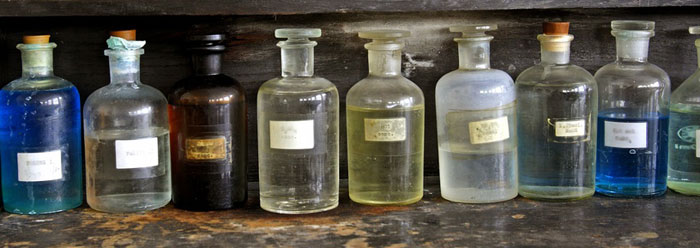When Stanley Miller passed away in 2007, his vials from the famous Miller-Urey origin of life experiments went to marine chemist Jeffrey Bada. Newer, more sensitive techniques were used on the old residue to detect additional amino acids, a discovery that one commentator suggested "might change our view about the chemical evolution of life."1
However, a separate study showed that the particular amino acids used in cells are extraordinarily nonrandom. How do these findings together relate to the question of how the first cell arrived on planet earth?
Many evolutionists believe that life originated in a "primordial soup" of organic molecules. In their 1950s experiments, Stanley Miller and Harold Urey tried to recreate the supposed chemical origins of life by firing sparks into glass chambers filled with gases chosen because each contributed the necessary elements. The resultant tar-like goo had trace amounts of some amino acids, the building blocks of life, so newspaper headlines proclaimed that the scientists were very close to forming life in a test tube.
After he inherited the samples collected during the experiments, Bada and colleagues examined vials from an experiment involving hydrogen sulfide and found "a wide diversity of amino acids that had never been reported before." In an interview with National Public Radio, Bada enthused:
I think it demonstrates that it's really easy to make key biomolecules like amino acids. And this then provides an inventory of raw material to set the stage for further reactions that lead to more complexity and eventually into something that wouldówe could call a living entity.1
But despite Bada's optimistic assessment of the study's results, the fact is that after decades of experiments, scientists are no closer to creating life in the lab than Miller and Urey were in the 1950s.
Individual amino acids are linked to form chains called proteins, which perform most of the required cellular tasks. Each amino acid has a central carbon atom from which four other chemical parts radiate. These include a hydrogen atom, the nitrogen atom of an "amine" group, a carbon atom from a "carboxyl" group, and a fourth unspecified atom or group of atoms.
It is that fourth unspecified position that distinguishes the different amino acids. Whereas hundreds of different amino acids could potentially be assembled, only 20 are used in the vast majority of proteins in living things.
Trace amounts of just a few of those 20 biologically relevant amino acids were originally known in the Miller-Urey samples. The new analysis of the samples revealed "a total of 23 amino acids,"2 including 10 found in living things and 13 hodgepodge amino acids.
But what quantities of these acids were formed by spontaneous sparking? The amounts of detected amino acids were so miniscule that they were not reported using standard units of chemical concentration: molar concentration, or molarity. Instead, they were reported in amounts relative to other amino acids in the mixture, and even so they were plotted on a logarithmic scale so that the chemical traces could be visualized on the same graph as the tiniest of traces.2
In 2008, Jeffrey Bada published a similar analysis of Miller-Urey vials without hydrogen sulfide.3 In that article, published in the journal Science, the authors described their reliance on a machine that could detect miniscule amounts in "the sub-picomolar level."4 In any origin of life by chance scenario, how did enough amino acids ever find one another amidst the sea of random chemicals?
In order to assemble a car, all the required parts have to be brought to the assembly line, not strewn all over the neighborhood. Similarly, no known natural mechanism gathers amino acids into close proximity. Rather, nature tends to disperse such chemicals over time.
But beyond the problem of low concentration of ingredients is that of having the right ingredients. A separate study analyzed the "choice," from among the possible hundreds, of amino acids used in living systems.5 The researchers found that the 20 essential amino acids have the widest range of chemical attributes, such as charge, hydrophobicity, and size. These particular 20 amino acid building blocks therefore maximize the potential for proteins to exhibit the widest possible range of variations in charge, hydrophobicity, and sizeófeatures they need in order to perform their jobs and make biological life possible.
If random processes were responsible for the "choice" of amino acids used in living things, then they all might have similar sizes, charges, and hydrophobic propertiesólike the amino acids formed in the Miller-Urey experiments.
But supplying uniform amino acids limits the range of structures that could be built with them, just like toy blocks of the same sizes and shapes would limit what a child could build.
Thus, according to the latest research, an intelligent agent was required to choose just the right set of building blocks for proteins. And a powerful agent was required to bring sufficient quantities of those building blocks together into one place to form living cells. Random nature doesn't fit either description, but the God of the Bible does.
References
- Did Ancient Eruptions Form Life's Building Blocks? National Public Radio. Posted on npr.org March 25, 2011, accessed April 18, 2011.
- Parker, E. T. et al. 2011. Primordial synthesis of amines and amino acids in a 1958 Miller H2S-rich spark discharge experiment. Proceedings of the National Academy of Sciences. 108 (14): 5526-5531. See the graph in Figure 2 for ratios of amino acids and amines.
- Thomas, B. Origin of Life Research Still Dead. ICR News. Posted on icr.org October 27, 2008, accessed April 15, 2011.
- Johnson, A. P. et al. 2008. The Miller Volcanic Spark Discharge Experiment. Science. 322 (5900): 404.
- Philip, G. K. and S. J. Freeland. 2011. Did Evolution Select a Nonrandom "Alphabet" of Amino Acids? Astrobiology. 11 (3): 235-40.
* Mr. Thomas is Science Writer at the Institute for Creation Research.
